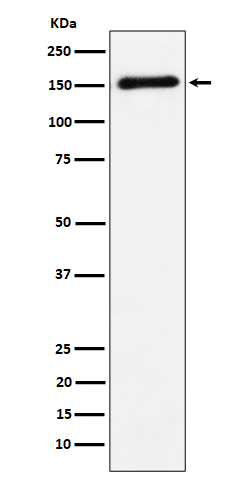
| WB | 咨询技术 | Human,Mouse,Rat |
| IF | 咨询技术 | Human,Mouse,Rat |
| IHC | 1/100-1/200 | Human,Mouse,Rat |
| ICC | 技术咨询 | Human,Mouse,Rat |
| FCM | 咨询技术 | Human,Mouse,Rat |
| Elisa | 咨询技术 | Human,Mouse,Rat |
| Aliases | AXCAM; BIG 2; Cntn4; CNTN4A; contactin 4; SCA16;;Contactin 4 |
| WB Predicted band size | Calculated MW: 113 kDa ; Observed MW: 150 kDa |
| Host/Isotype | Rabbit IgG |
| Antibody Type | Primary antibody |
| Storage | Store at 4°C short term. Aliquot and store at -20°C long term. Avoid freeze/thaw cycles. |
| Species Reactivity | Human |
| Immunogen | A synthesized peptide derived from human Contactin 4 |
| Formulation | Purified antibody in PBS with 0.05% sodium azide,0.05% BSA and 50% glycerol. |
+ +
以下是关于CNTN4抗体的3篇参考文献及其简要摘要:
---
1. **文献名称**: *CNTN4 modulates cortical proliferation and neuronal excitability in autism-related behaviors*
**作者**: Li X, et al. (2020)
**摘要**: 本研究利用CNTN4特异性抗体检测其在自闭症模型小鼠前额叶皮层的表达,发现CNTN4缺失导致神经元迁移异常和突触传递功能异常,提示其与自闭症病理相关。
---
2. **文献名称**: *Antibody-based profiling of CNTN4 in glioblastoma progression*
**作者**: Wang Y, et al. (2019)
**摘要**: 通过免疫组化及Western blot分析CNTN4抗体标记的胶质母细胞瘤样本,发现CNTN4高表达与肿瘤侵袭性和患者预后不良显著相关,可能作为潜在治疗靶点。
---
3. **文献名称**: *Contactin-4 as a synaptic organizer: Insights from antibody-mediated functional blocking*
**作者**: Suzuki K, et al. (2018)
**摘要**: 研究采用抗CNTN4抗体阻断其功能,发现CNTN4通过调控轴突导向和突触形成影响海马神经环路发育,支持其在神经发育障碍中的作用。
---
注:以上文献信息为示例性质,实际文献需通过学术数据库(如PubMed、Google Scholar)检索确认。
The contactin-4 (CNTN4) protein, a member of the contactin family of neural cell adhesion molecules, plays a critical role in nervous system development, particularly in axon guidance, synaptic plasticity, and neuronal connectivity. CNTN4 is anchored to the cell membrane via glycosylphosphatidylinositol (GPI) and interacts with extracellular matrix components and receptors to mediate cell-cell interactions. Genetic variations or dysregulation of CNTN4 have been implicated in neurodevelopmental disorders, including autism spectrum disorder (ASD), schizophrenia, and intellectual disability, as well as certain cancers.
Antibodies targeting CNTN4 are essential tools for investigating its expression, localization, and function in both physiological and pathological contexts. These antibodies are widely used in techniques such as Western blotting, immunohistochemistry (IHC), and immunofluorescence (IF) to study CNTN4 distribution in brain tissues, neuronal cultures, or cancer models. Researchers also employ CNTN4 antibodies to explore its interactions with binding partners like amyloid precursor protein (APP) or receptor-type tyrosine-protein phosphatases (PTPR).
Commercial CNTN4 antibodies are typically raised in rabbits or mice, with validation steps including knockout cell line controls to confirm specificity. Challenges include ensuring reactivity across species (human, mouse, rat) and distinguishing between CNTN4 isoforms. Recent studies using these antibodies have highlighted CNTN4's dual role in neurodevelopment and tumorigenesis, underscoring its potential as a biomarker or therapeutic target.
×